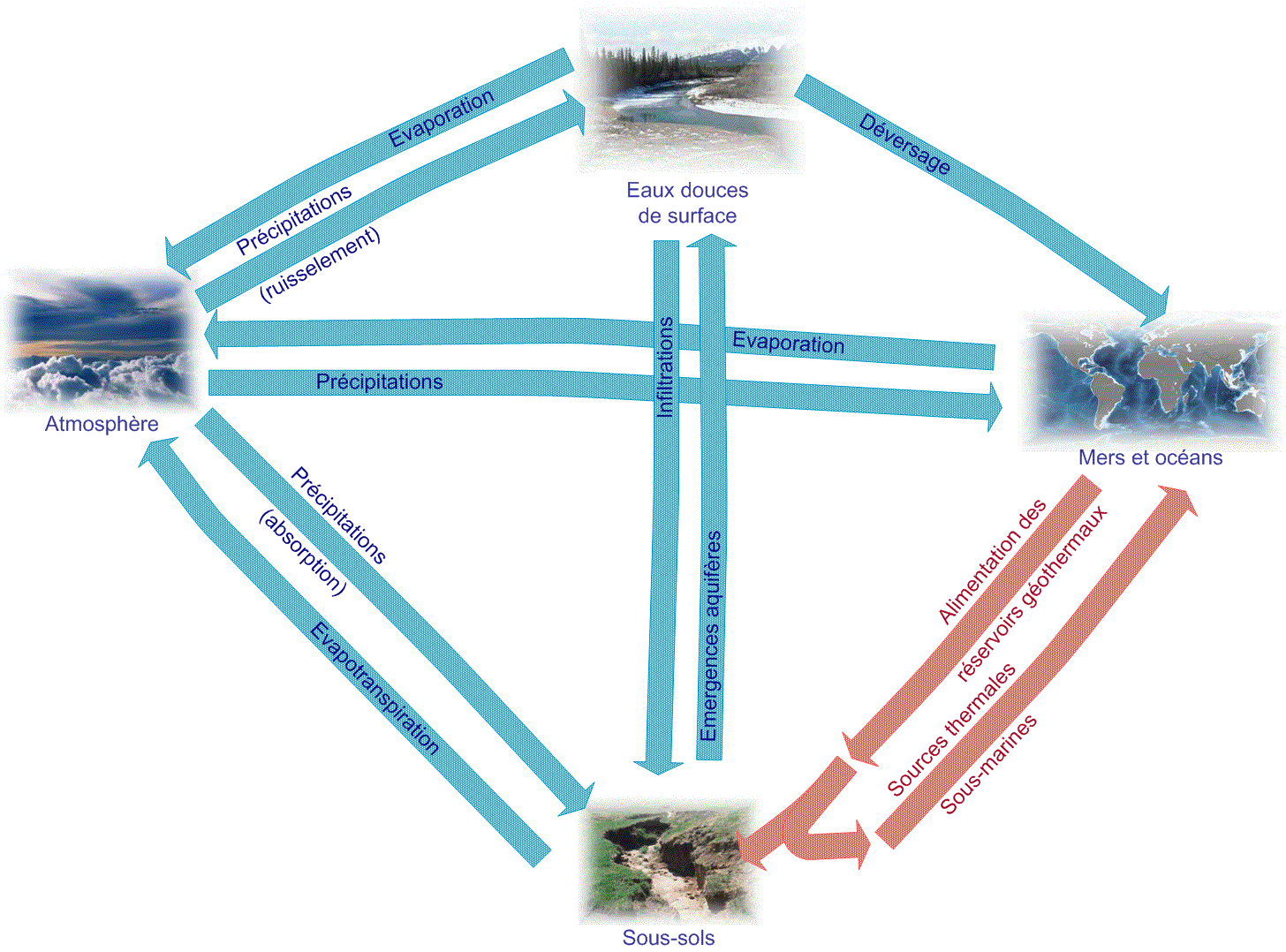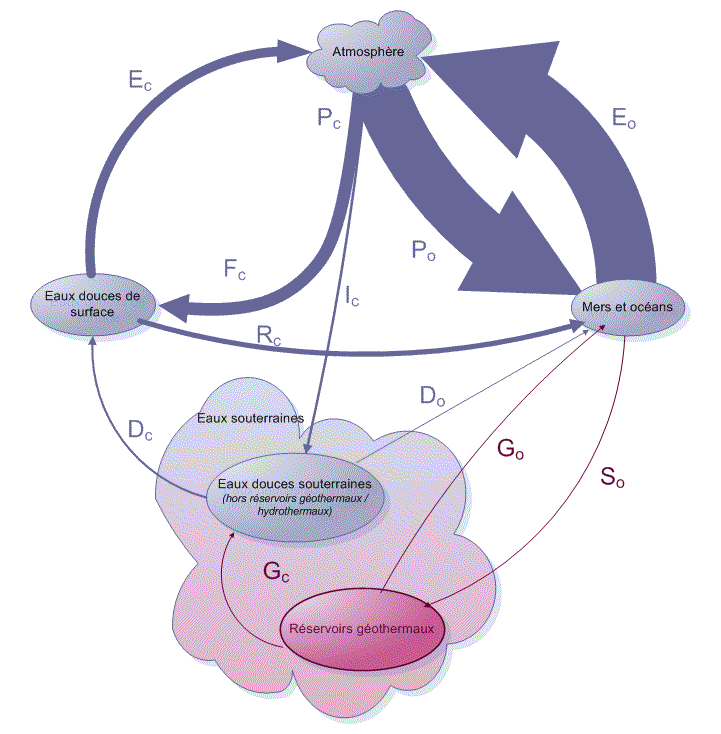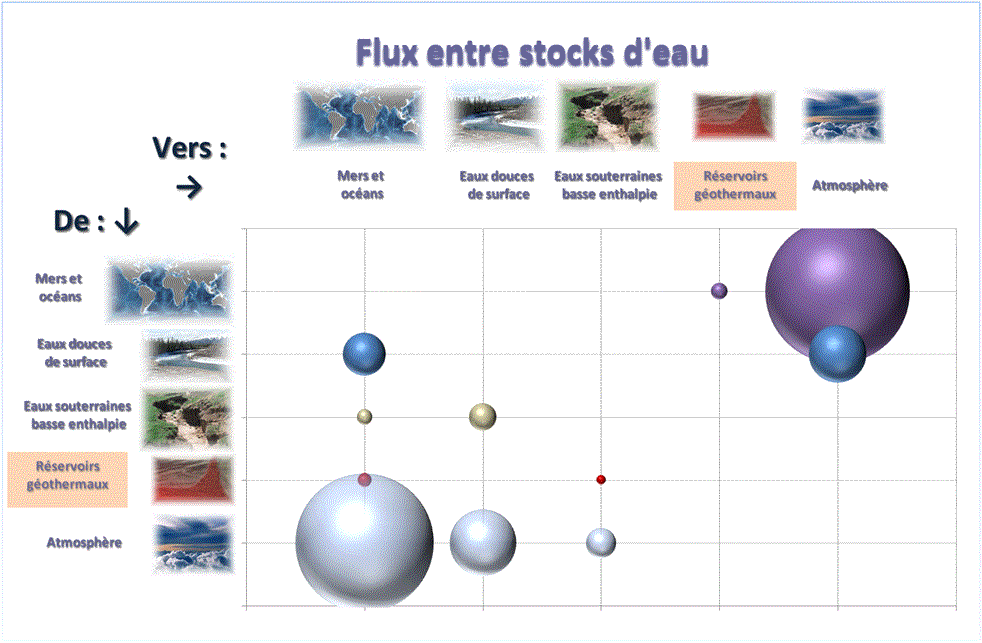The cycle of water
The feeding of the ascending water cycle from geothermal reservoirs to the ground surface constitutes a key aspect of the water cycle. The nature of the flow giving birth to this cycle is qualitatively given and quantitatively described. The global sizing of this flow enables to determine the geothermal potential of deep underground flows.
Why underground flows are essential?
If the intention is to collect underground water flows resulting from geothermal reservoirs or hydrothermal, it is useful to understand the origin and to evaluate the importance of these flows on the level of planet. The angiogeoscopy does not make it possible to detect related flows (of entry) of the geothermal reservoirs, only efferent flows (of exit). Since the mode is steady state - what is always the case for this kind of reservoir with great depth - the incoming flow and of exit balance. What leaves there continuously and natural - and that it is useful to collect - must return also there. The origin of this water feeding, quantified below, is approached in the introduction to the geothermal reservoirs. The quantification of this water feeding - key in the cycle of water - results statistically from efferent flows (outgoing) of the geothermal reservoirs. From this quantification rises the total potential from the geothermics based on natural aqueous flows.
Principal Flows
The diagram below presents macroscopic a view known as “to coarse grain” of the cycle of water at the planetary level. Flows of less importance (like those exchanged with the biomass) and the subdivisions of principal flows are not represented. The part of this useful diagram for the comprehension of the starter of the ascending water cycle corresponds to flows between the oceanic funds and the subsoil, represented in red.
Macroscopic Sight of the cycle of water
General Principles
To Study the cycle of water supposes to consider two complementary aspects:
- stocks (or types) of water resources,
- flows between these stocks (or types) of water resources.
The taxonomy (classification) of water stocks is eminently arbitrary. It will put off for a hydrogeologist, who are interested especially in underground flows, and for hydrologist who concentrates on flows on the surface. The smoothness of cutting and/or the scope of application of the aqueous assessment also differ according to the finality from the study.
Flows can fluctuate according to the period considered (dry season or wet season) or according to their local or total character. Our interest relates primarily to flows which feed and come from geothermal reservoirs. As these flows are steady state, it is legitimate to take the year like base period to smooth the influence of the fluctuations of the other flows implied in the cycle of water.
The estimates of water stocks and underground water flows presented below are based on a consolidation of estimates resulting from the literature. The geothermal flows, represented in red, are founded on the extrapolation of a sample statistically representative of the average density of the points of exurgence and their medium flow. These sizes can be estimated at the local level by angiogeoscopy.
Estimate of flows
The table below presents an estimate of flows between principal water stocks of planet:
| Flow of exchange (in 103 km/an3) | Towards: → (entering flow) | Seas and oceans | Fresh waters of surface | Groundwaters (low enthalpy) | Geothermal reservoirs | Atmosphere | Proportion (of total flow) |
| Of: ↓ (outgoing flow) | Total: → and ↓ | 458.56 | 110.40 | 20.64 | 5.77 | 523.80 | 100% |
| Seas and oceans | 458.09 | negligible | negligible | 5.77 | 452.32 | 40,95% | |
| Fresh waters of surface | 110.40 | 38.92 | negligible | very weak | 71.48 | 9,87% | |
| Groundwaters (low enthalpy) | 20.64 | 4.91 | 15.73 | negligible | 0.00 | 1,84% | |
| Geothermal reservoirs | 5.77 | 4.08 | negligible | 1.68 | 0.00 | 0,52% | |
| Atmosphere | 523.80 | 410.18 | 94.67 | 18.65 | 0.00 | 46,82% | |
| Proportion (total flow) | 100% | 40.95% | 9.87% | 1.84% | 0.52% | 46.82% |
Flow between water stocks on a world level and over one year
The unit of the sizes mentioned on this table corresponds to a cube of 10 side km.
Hydrogeological flows are indicated in clear red. They are weak compared to other flows, but correspond nevertheless to an appreciable geothermal potential. The food of fresh waters of surface starting from ground waters comes, at the same time, of percolation waters (to a small extent) and ascending flow from the geothermal reservoirs and hydrothermal.
Estimate of water stocks
Flows presented above are established between water stocks mentioned below:
| Water resources | Quantity (in 106 km 3) | Proportion (in %) | Average Duration of renewal (in days) | Average Duration of renewal (in years) |
| Seas and oceans | 1,350 | 97.38% | 1,075,664 | 2,947 |
| Fresh waters of surface | 27.20 | 1.96% | 89,928 | 246 |
| Underground Fresh waters (ground and subsoil) | 9.07 | 0.65% | 125,302 | 343 |
| Atmosphere | 0.01 | 0.001% | 9 | 0.025 |
| Total | 1,386 | 100% |
Water Stocks on the level of planet
Each stock mentioned above is subjected to an entering flow and an outgoing flow (which is equal over one one year period).
Water stocks are by no means proportional to flows which theirs are associated. Thus, the atmosphere constitutes a relatively weak water stock. On the other hand, flows which forward there are very important. The relationship between a water stock and flows which are associated for him determine the average duration of renewal of this water stock. This One is indicated in the two columns of right-hand side (in days and years). The geothermal reservoirs present very long durations of renewal. The effects of a pollution are thus very difficult there to erase.
Schematic Representation
The diagram below graphically illustrates the exchanges between water stocks. The thickness of the features is proportional to the importance of flows.
Schematic Visualization of the importance relative of flows on a world level
Chart
The graph below watch the proportion of the various types of water flow enters the various types of water stock:
Graphic Visualization of the importance relative of flows on a world level
Each crossing on the diagram corresponds to a particular flow. With largest the ball which is positioned there, with most important flow.
Power Supply of the geothermal reservoirs and hydrothermal
Even weak compared to other flows, flows crossing the geothermal reservoirs have a considerable importance. They initiate ascending underground water flow and balances flows of infiltration to make it possible water to arise from the ground. The underground water flows from the geothermal reservoirs and located under not immersed surfaces determine the exploitable geothermal potential.



